Shopping
Many of Lisbon’s shops seem not to have changed in style for at least 100 years, and have an appealing old-fashioned aesthetic, while in the narrow streets of Bairro Alto, young designers show off their latest creations and have DJs playing while you browse. Here you can buy handicrafts, notably ceramics, which have been produced in the same way for hundreds of years. There are also chic boutiques, glittering malls and a wonderfully scruffy outdoor market.
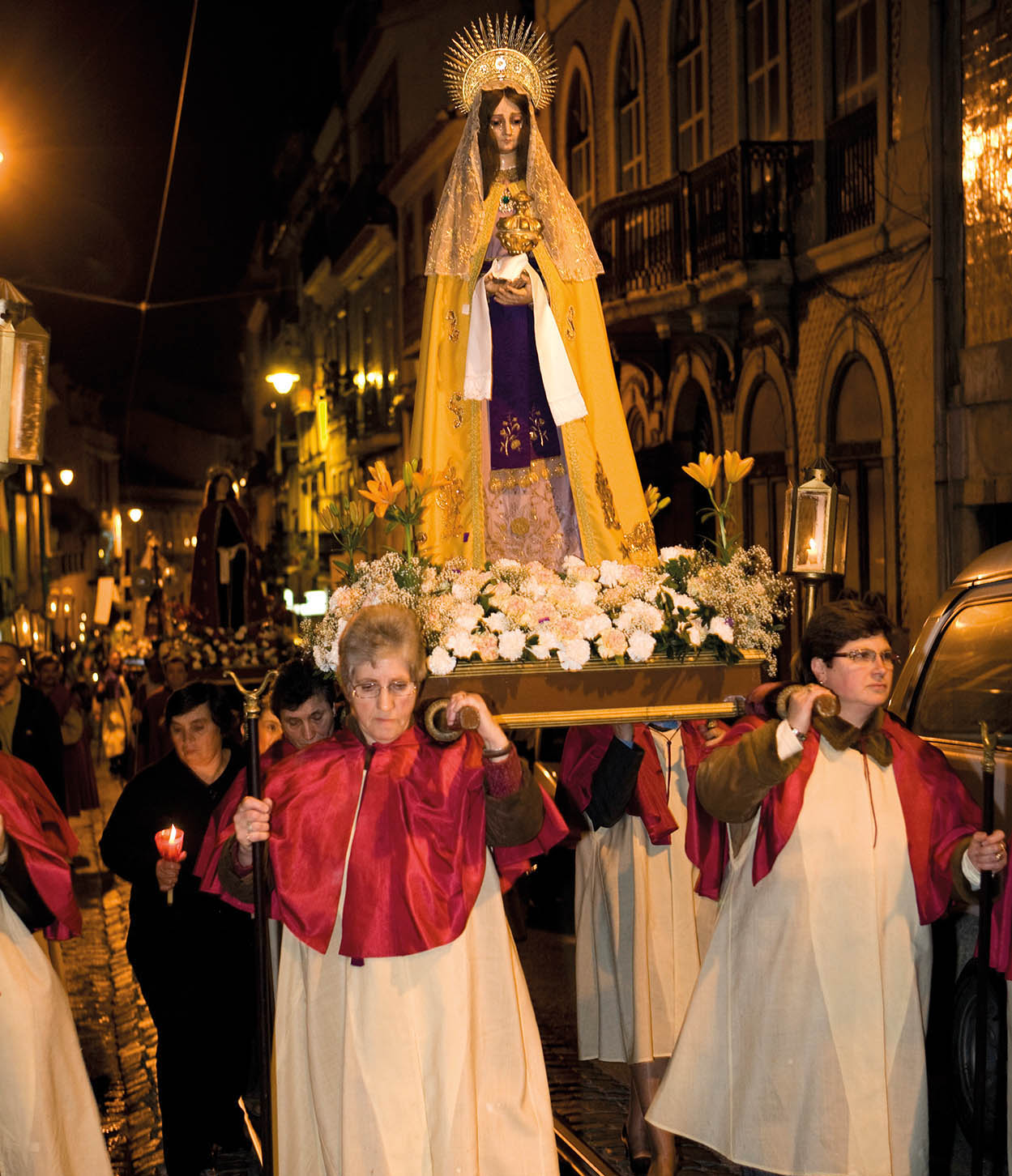
Easter Procession
Lydia Evans/Apa Publications
Shopping Card
The Lisboa Eat and Shop Card offers discounts of up to 15 percent in Baixa, Chiado and Av. Liberdade. The card is available in one- and two-day versions from Turismo de Lisboa offices.
Best buys
Handicrafts excel in Portugal. Azulejos, the hand-painted ceramic tiles that have been decorating Portugal’s walls throughout the centuries, are one of the top crafts. You can buy a scene on a single blue-and-white tile, an address plaque for your house or a batch to assemble into a picture when you get home. Some shops will paint tiles to order if you have a particular design in mind, and some will copy a photograph.
Delicate Portuguese embroidery and lacework, especially samples by women on the island of Madeira, is excellent. Hand-embroidered goods, such as tablecloths, napkins and hand towels, also come from the Azores and some mainland towns, notably Viana do Castelo.
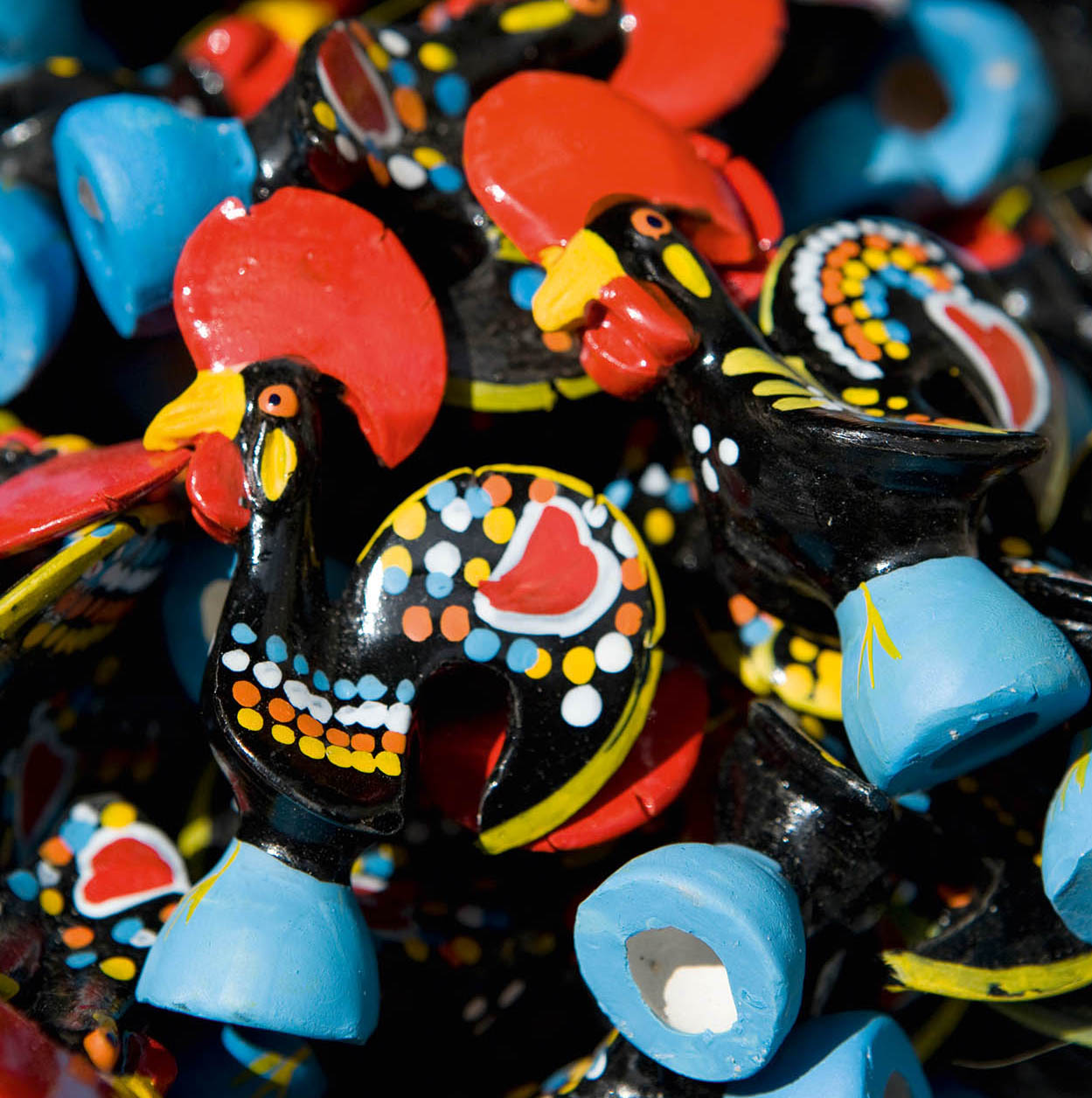
Hand-painted cockerels
Lydia Evans/Apa Publications
Filigree work is of very high quality. Look for silver filigree earrings and delicate brooches, often in the form of flowers or butterflies. Portuguese pottery and ceramics are found in many designs and colours, from fine porcelain Vista Alegre to folksy earthenware. Hand-painted brightly coloured cockerels from Barcelos are the ubiquitous national symbol.
Arraiolos, an Alentejo village, has been making fine wool rugs in bright colours and graceful designs for centuries. Hand-woven baskets, which differ by region, are strong, utilitarian and often pretty. Artefacts made from cork are typical; Portugal is the world’s leading producer, not only for wine bottles, but also for umbrellas and bags.
Portugal has long been famous for its fortified port wine from the Douro Valley near Oporto in the north. Best known as an after-dinner tradition, it also comes in aperitif versions (click here). Vintage port from the most select years is what connoisseurs and collectors seek, but there are more accessible ports to take home. Look for aged tawny, LBV (late bottle vintages) or, for something a little more unusual, a bottle of white port.
Madeira wine, from the volcanic soil of the Portuguese island in the Atlantic, is served either before dinner or afterwards as a dessert wine. While these regional wines get much of the attention, Portugal also produces a number of excellent red and white table wines. Look for those from Dão and Alentejo, as well as vinhos verdes (young wines) from the Minho.
To enjoy the sounds of Portugal back home, take home a classic fado recording, perhaps by the late Amália Rodrigues or by Carlos Paredes.
A number of high-fashion designers from Portugal – such as Ana Salazar and Fátima Lopes – have gained international attention, and Chiado and Bairro Alto are good places to seek them out. Hand-knitted pullovers in sophisticated designs or chunky fishermen’s sweaters from Nazaré are good buys.
The Portuguese leather industry is known throughout the world and jackets, belts, bags, wallets and shoes are popular and good-value buys.
Where to shop
Most city shops are open Monday to Friday from 9 or 10am to 7pm (smaller ones might take a lunch break, usually between 1 and 3pm); the more traditional shops close on Saturday at 1pm. Modern shopping malls are usually open from 10am to midnight or later, and sometimes on Sunday. Some of the Baixa shops stay open during lunchtime.
The Chiado district is the place to go for books, smart designer wear and interior design, especially the Armazéns do Chiado mall (www.armazensdochiado.com) and Rua Garrett. The French-owned Fnac department store here is popular.

Haberdasher’s facade in Baixa
Lydia Evans/Apa Publications
The central grid of streets around Rua Augusta in the Baixa contains wonderfully atmospheric shops, sustained by low rents. Traditional foodstuffs, clothing and jewellery are all sold here.
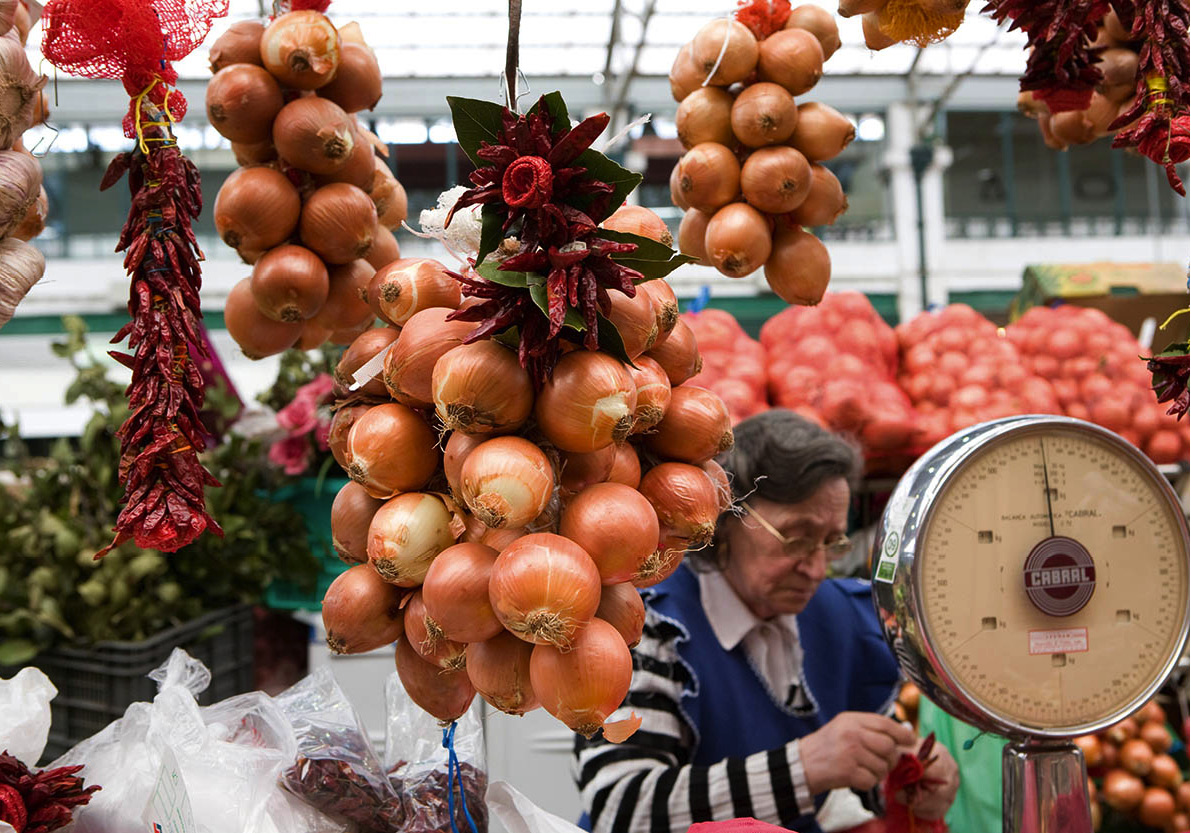
Local produce in Mercado da Ribeira
Lydia Evans/Apa Publications
Across the street from Cais de Sodre station is the renovated, 19th-century Mercado da Ribeira (Sun–Wed 10pm–midnight; Thur–Sat 10pm–2am), which houses a daily food market, full of colourful produce, and selling everything from piri-piri sauce to formal flower arrangements. At night the market becomes a foodies’ paradise with dozens of food stalls representing the best restaurants in Lisbon. Tasting menus are great value and the place has already become one of the favourite meeting points for locals and tourists alike. Markets are fun for their ambience as much as the goods on offer. Behind São Vicente de Fora church, in the Campo de Santa Clara, the Feira da Ladra (‘Thieves’ Market’) is held on Tuesday and Saturday from dawn to dusk. On the fringes of the kitchenware and clothing stalls are dusty treasures and an incredible range of second-hand items.
Lisbon has two main shopping centres. Amoreiras (Avenida Engenheiro Duarte Pacheco; www.amoreiras.com) is a pastel-coloured complex laid out over three floors. It houses banks, a post office, cinemas, a health club, supermarkets, a chapel, art galleries, eating places and some 300 shops selling goods from furniture and linen to music, books, china and chocolate. Centro Columbo (Avenida Lusiada, Benfica; www.colombo.pt) is the city’s largest shopping centre, more akin to a massive leisure complex than a mere shopping mall. Come here for all the major chains, plus a nursery, chapel, cinema, health club, golf driving range, bowling alley and funfair. Alternatively, head for the largest branch of the Spanish chain El Corte Ingles (Avenida Antonio Augusto Aguiar, 31; www.elcorteingles.pt) or Atrium Saldanha (Praça Duque de Saldanha), with a great variety of snack and light meal options.
Out near Cascais, beside the motorway, CascaiShopping (www.cascaishopping.pt) is another shopping complex. For easy shopping closer to town, you might like to try the Centro Commercial de Alvalade and the fashionable but generally expensive Avenida da Roma.
Entertainment
The Portuguese capital is a great place to party, with venues ranging from fado speakeasies to superclubs, and from African nightclubs to alternative bars, clustered in various areas around the city.
Nightclubs, bars and live music. The classic nighttime outing in Lisbon is still to the fado houses in Alfama or Bairro Alto. A century ago, ‘respectable’ people were reluctant to be seen in a fado club; nowadays the danger is not to your reputation, only to your wallet, as tickets and drinks are quite expensive. Many offer dinner as well as drinks.
Fado
Fado, the soulful Portuguese song – literally ‘fate’, translated into music – is based on a story or poem and accompanied by a 12-string guitar. The dramatic atmosphere of a fado house adds to the occasion. Guitarists start off the proceedings with a warm-up number. The lights dim, the audience goes quiet, and a spotlight picks out a woman in black who begins to wail out a song of tragedy and despair. Her sultry voice sums up that most Portuguese emotion, saudade – a swell of longing, regret and nostalgia. Though most often characterised by melancholy or despair, there are also joyful and relatively upbeat fados.
Most fado singers are women, but you are also likely hear a man perform the same sort of ballad with a strong, husky voice.
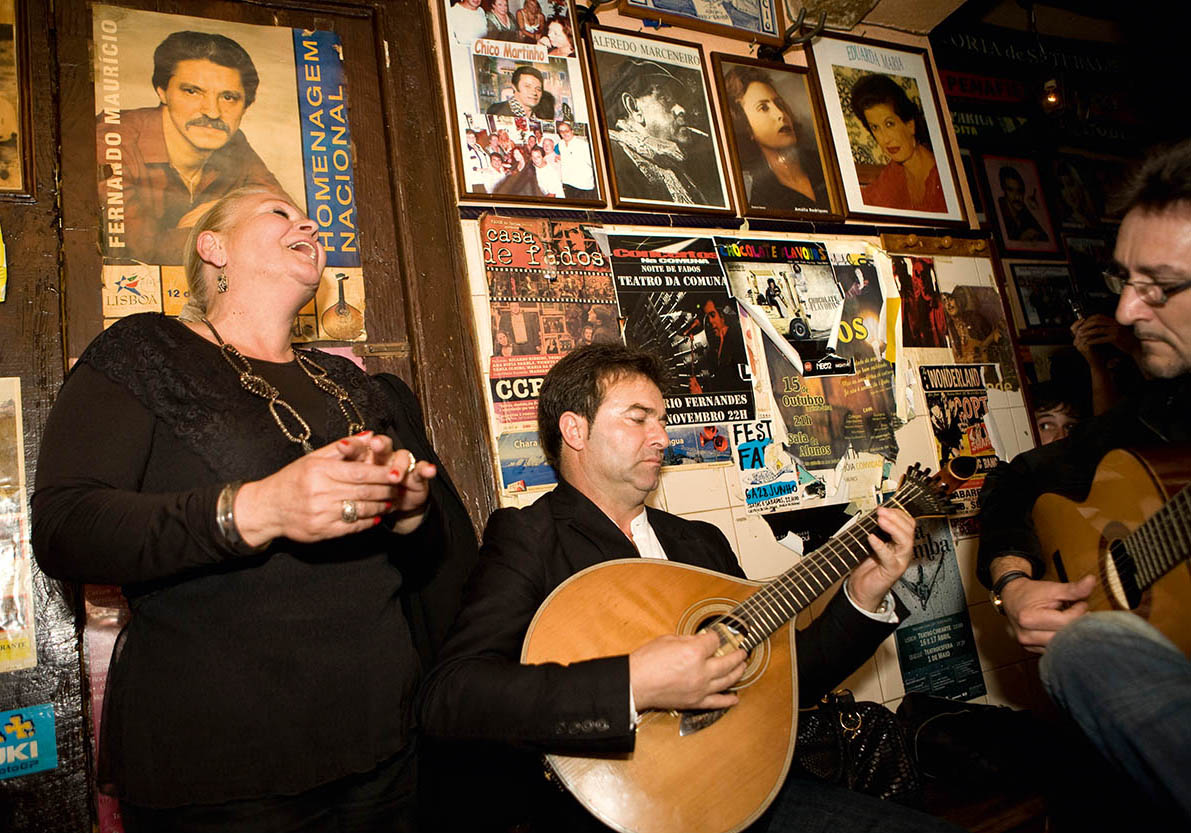
Fado performers
Lydia Evans/Apa Publications
Good fado clubs include Senhor Vinho (Rua do Meio à Lapa 18; tel: 213-972 681; www.srvinho.com), Alfama’s A Baîuca (Rua de São Miguel 20; tel: 218-867 284), a low-key local place, and Fado in Chiado (Espaço Chiado, Rua da Misericordia 14; www.fadoinchiado.com).
Nightlife areas are clustered around dock areas, and these venues tend towards a more mainstream crowd, but the biggest buzz is to be found in Bairro Alto, where there are nightclubs, jazz clubs and bars for all tastes, some open until 5am.
Eclectic bars include gay-friendly Portas Largas (Rua da Atalaia 105) and the jazz-centred Catacumbas (Travessa da Água da Flor 43), which has regular live music. Long-running nightclub Frágil (Rua da Atalaia 126) is perennially popular, playing a mix of music from pop to indie. North of Bairro Alto, the area around Principe Real is the centre of the city’s gay scene and also home to the fantastical bar, Pavilhão Chinês (Rua Dom Pedro V 89-91), worth a visit for a cocktail amid its extraordinary crazy-attic, clutter-lined decor.
The club to visit in Lisbon is riverside Lux (Avenida Infante Dom Henrique), which is run by nightlife guru Marcel Reis and part owned by John Malkovich. It’s enduringly chic, edgy and interesting, despite being a super-club.
Concerts and dance. Lisbon’s cultural scene offers occasional opera, symphony concerts, ballet and recitals, usually held in winter. The city’s opera company is well regarded, and the Gulbenkian Foundation (for more information, click here) maintains its own symphony orchestra and ballet company.
Portugal has three other important symphony orchestras and a national dance company.
Venues include: Coliseu dos Recreios (Rua das Portas de Santo Antão 96; tel: 213-240 580, www.coliseulisboa.com), the second-largest music and events hall in Lisbon; MEO Arena (Parque das Nações; tel: 218-918 409, www.arena.meo.pt), the place for big-time rock bands and Brazilian acts; Museu Gulbenkian (Avenida de Berna 45; tel: 217-823 000, www.gulbenkian.pt), which hosts varied recitals, classical music and dance programmes, including open-air concerts in summer; Teatro Nacional de São Carlos (Rua Serpa Pinto 9; tel: 213-253 000, www.saocarlos.pt), Lisbon’s opera house; and Centro Cultural de Belém (Praça do Império; tel: 213-612 400, www.ccb.pt), which has a wide programme of cultural performances.
Theatre and cinema. Most of Lisbon’s stage plays are comedies and revues – in Portuguese, of course. The best-known theatre is Teatro Nacional de Dona Maria II (Praça de Dom Pedro IV, Rossio; tel: 213-250 800, www.teatro-dmaria.pt).
Cinemas tend to show foreign films in the original language with Portuguese subtitles. São Jorge (Avenida Liberdade 175; tel: 213-103 402, www.cinemasaojorge.pt) is a pleasantly renovated cinema with three screens, and often hosts festivals.
Gambling. The Estoril Casino (tel: 214-667 700, www.casino-estoril.pt; for more information, click here) is the big draw for gamblers. To enter the gaming rooms you have to pay a fee and show your passport. The casino is open daily 3pm–3am (closed Christmas Eve). A sign suggests that gentlemen wear jackets after 8pm, but no rules are enforced.
Sports
From swimming and hiking to deep-sea fishing, sports enthusiasts have plenty of options in the Lisbon area. The temperate climate also means year-round golf and tennis. If you’re interested in diving or water skiing, or any other sport for which you need to hire equipment, ask at the tourist information offices in each town about the best places to do so.
Active sports
Diving. Just off Sesimbra, south of Lisbon, the clear, calm waters are very good for snorkelling and scuba diving.
Fishing. All along the coast you will see anglers in boots casting off from the beaches, and others perched on rocks or man-made promontories. The best deep-sea fishing is for swordfish around the coast of Sesimbra (contact Marlin Boat Tours; www.marlinboattours.com).
Golf. The Lisbon and Tagus Valley area has 18 courses, including top-rated Estoril Golf Club (18 holes; tel: 214-680 176), one of the oldest in the country, at Estoril; Estoril Sol Academia (9 holes; tel: 219-240 331) near Sintra; Lisbon Sports Club (18 holes; tel: 214-310 077) at Belas near Queluz; and Quinta da Marinha (18 holes; tel: 214-860 100) near Cascais, designed by Robert Trent Jones.
Riding. You can hire a horse, with or without an instructor, at the Belas Clube de Campo (www.belasclubedecampo.pt) or at the Quinta da Marinha (see above), which also has an equestrian centre.

Canoes lined up at Praia dos Pescadores, Cascais
Lydia Evans/Apa Publications
Sailing and boating. Most beaches protected from the open ocean have rowing boats, canoes or pedalos for rent by the hour. Experienced sailors in search of a more seaworthy craft should ask at the local yacht marina. Rowing boats are also available at Parque das Nações near the Oceanário.
Swimming. Because of pollution along the Estoril Coast, you should not swim in the sea any closer to Lisbon than at Estoril itself, which has been granted an EU blue flag. At Guincho and beyond, the sea is perfectly clean and quite safe for swimming, but beware of the strong undertow. South of Lisbon from Caparica onwards is delightful, but can also be windy, with very rough seas.
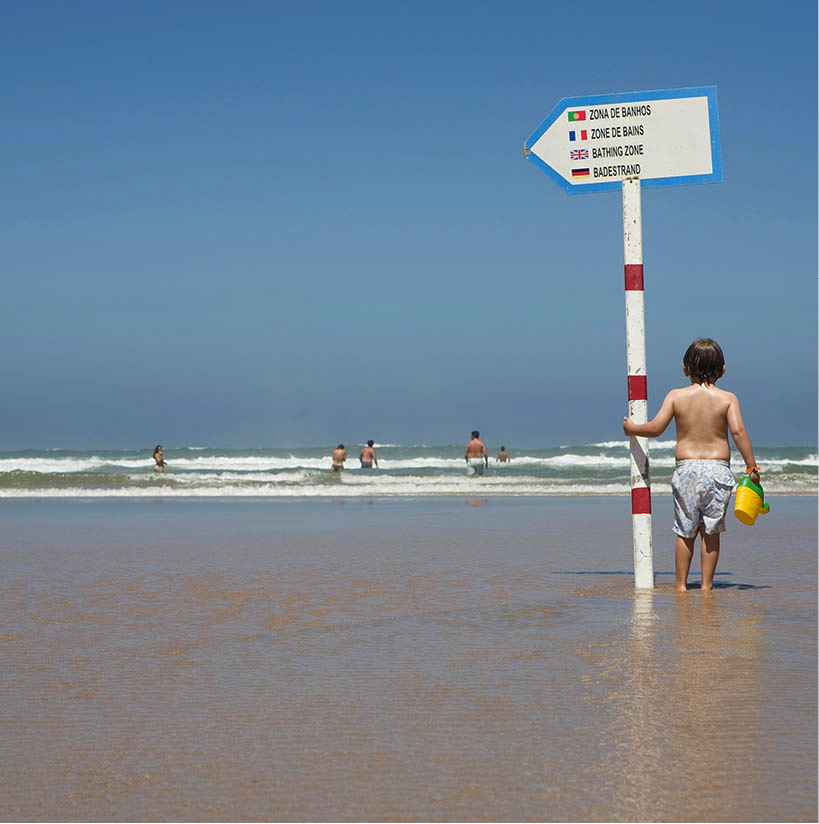
Day trip to the beach
Lydia Evans/Apa Publications
Tennis. Major hotels tend to have their own tennis courts, but there are tennis clubs and public courts as well. Many golf clubs also have tennis courts.
Spectator sports
Bullfights. Portuguese bullfighting follows a style called Arte Marialva. Unlike Spanish bullfights, the bull – its horns sheathed – is not killed. There’s artistry in the partnership between the splendidly dressed cavaleiro and his horse but, as barbed darts are planted into the bull’s upper back, bullfighting remains a bloody spectacle. The horseman is aided by a back-up team, peões de brega, with distracting capes. They are succeeded in the arena by an eight-man team of volunteer forcados, wearing tight breeches, white stockings and short coat, who face the bull barehanded. All performers are judged on skill, style and courage. At the end the bull is led away among farm steers and is afterwards butchered.
Lisbon’s Campo Pequeno Praça de Touros bullring (tel: 217-820 575, www.campopequeno.com), at the top of Avenida da República, is a Victorian red-brick landmark with mock-Moorish arches and bulbous domes. The season runs from Easter Sunday to October. As in Spain, seats in the shade (sombra) cost more than in the sun (sol), though there are performances in the evening as well. For a modicum of comfort, rent a pillow from the usher.
Motor racing. Races and events take place at Estoril’s Autodrome.
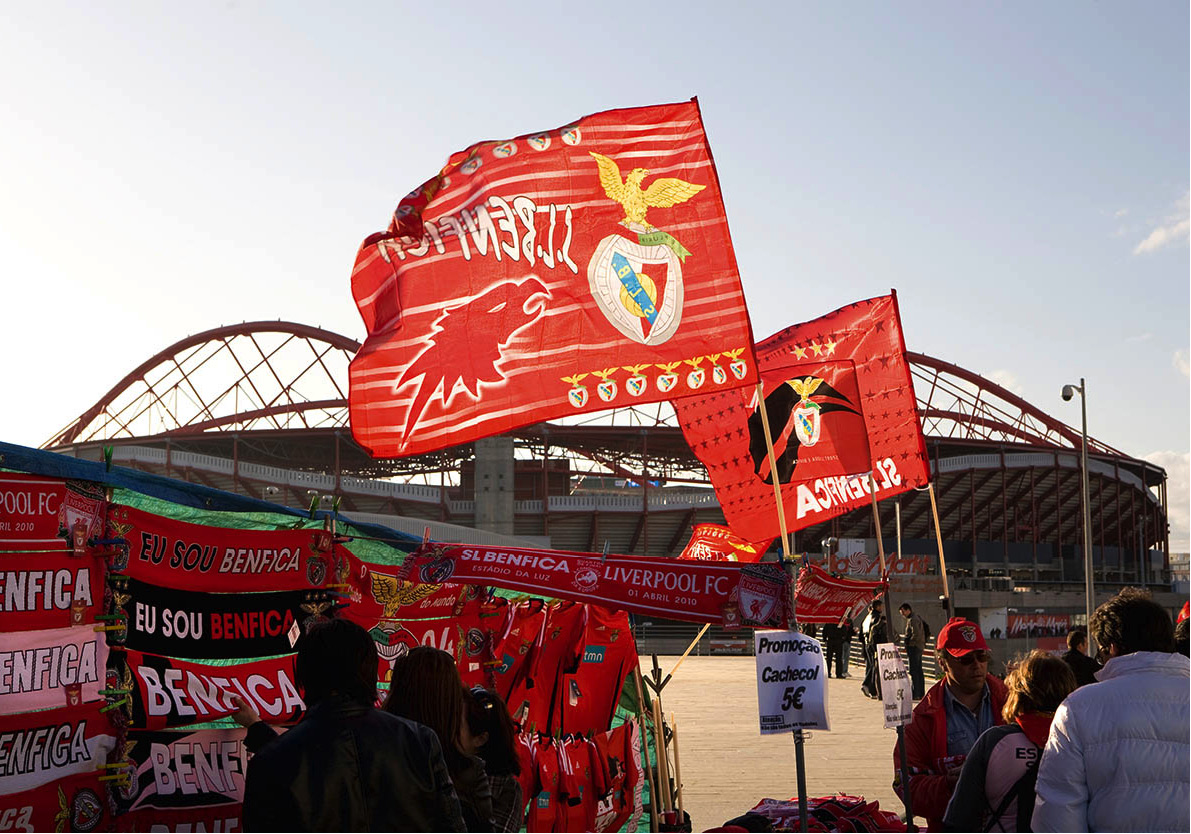
Football flags flying at Benfica
Lydia Evans/Apa Publications
Football (Soccer). Football draws big crowds in Portugal. Lisbon’s two major teams are Benfica, which plays at the Estádio da Luz, and Sporting Clube de Portugal, which holds matches at Estádio do José Alvalade near Campo Grande.
Children’s activities
With its trams, elevators, funiculars, ferries and tourist trains, Lisbon offers some great ways to entertain children just by touring around the city. Take the Transtejo ferry to Belém or the Parque das Nações, which has a splendid aquarium (Oceanário de Lisboa, for more information, click here), playgrounds, fountains, paddleboats and aerial cable cars. The Planetário Calouste Gulbenkian in Belém (for more information, click here) has special planetarium shows for children on Sunday mornings.
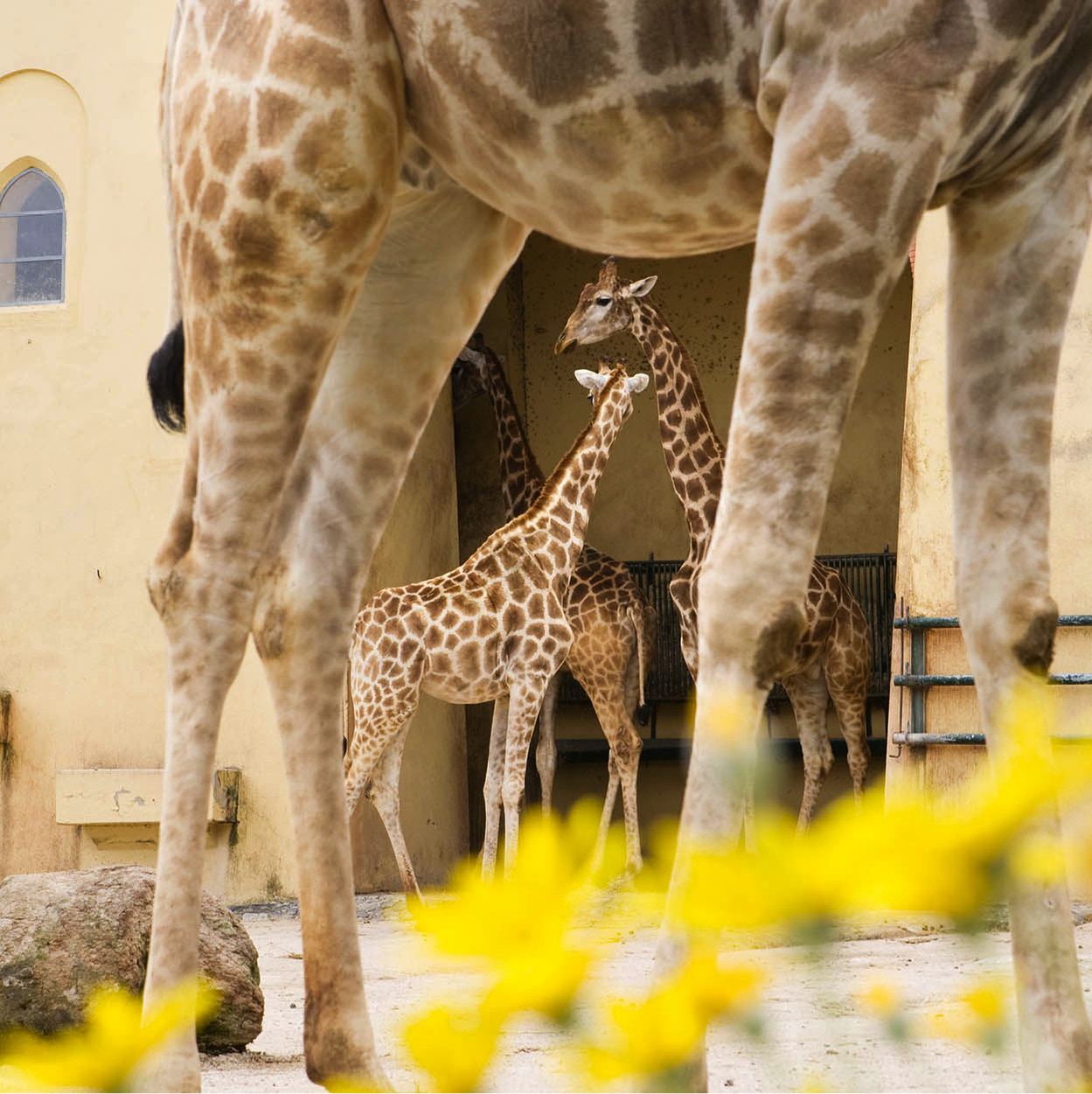
Giraffes at the zoo
Lydia Evans/Apa Publications
North of the aqueduct is Jardim Zoológico de Lisboa (Zoo, Estrada de Benfica 158–60; tel: 217-232 900/910; www.zoo.pt; daily 10am–6pm, until 8pm Apr–Sept;). There are elephant rides, boats and a miniature train, and shows at various times of day when animals from parrots to dolphins are fed. There is also Tapada Nacional de Mafra, a wildlife park with deer, wolves and wild boar at Mafra (www.tapadademafra.pt; daily 9am–5pm, till 6pm on weekends and holidays).
Campo Grande, between the zoo and the airport, is a popular park. Palm, cedar and willow trees shade pretty walks, and there’s a small lake with rowing boats.
For a safe beach with clean water you’ll have to travel some way from the city (for more information, click here). Head for Guincho and Caparica when the wind is light, or Sesimbra and Tróia otherwise. Caparica has a water park with long, twisting slides.